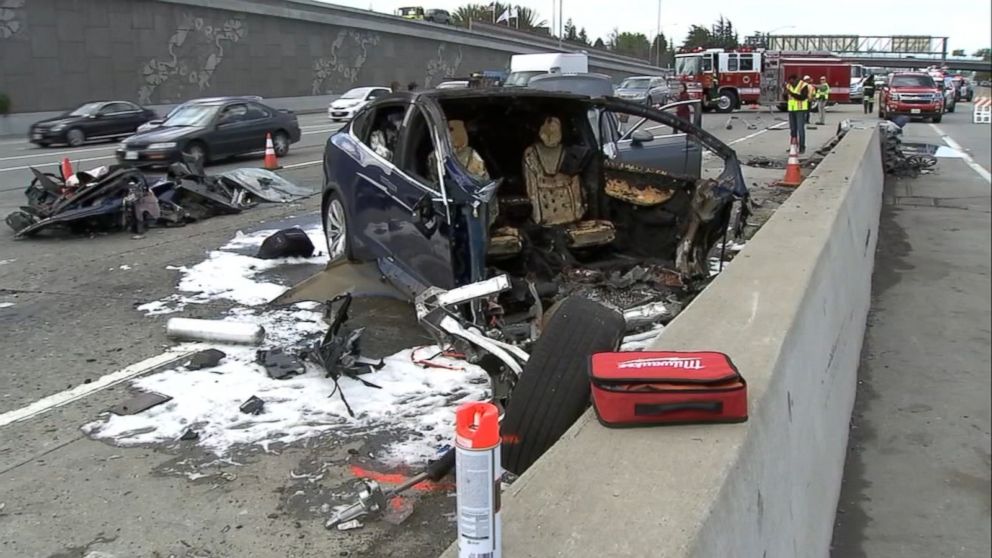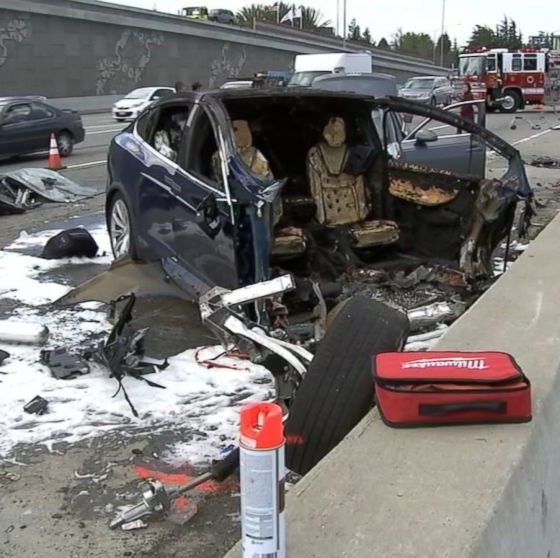

News
NTSB Prelim Report on fatal Tesla Model X crash: 8-seconds before impact
The National Transportation Safety Board has issued a preliminary report on the tragic Tesla Model X crash near Mountain View, CA in March. The NTSB’s preliminary report provided details about the circumstances leading up the accident, as well as observations about the all-electric SUV’s battery pack five days after the crash.
According to the NTSB, preliminary recorded data revealed that the Tesla Model X had its Autopilot engaged with Traffic-Aware Cruise Control set to 75 mph at the time of the accident. The vehicle collided into the crash attenuator, rotating it counterclockwise, removing the front part of the vehicle, and causing subsequent collisions with a 2010 Mazda 3 and a 2017 Audi A4. The NTSB noted that the vehicle’s performance data revealed the following.
- Autopilot was engaged on four separate occasions during the 32-minute trip. The driver-assist feature was engaged for the last 18 minutes 55 seconds before the collision.
- During the 18 minute, 55-second period, the Model X provided two visual and one auditory alert advising the driver to place his hands on the car’s steering wheel. The alerts were triggered more than 15 minutes prior to the accident.
- For the last 6 seconds before the collision, the Model X’s driver did not have his hands on the steering wheel.
- At 8 seconds before the crash, the Model X was following a lead vehicle at about 65 mph. At 7 seconds, the Model X began moving left while still following a lead vehicle. At 4 seconds, the Tesla was no longer following a car. At 3 seconds before the accident, the Model X’s speed increased from 62 mph to 70.8 mph. The vehicle’s emergency braking and evasive steering did not engage.
- During the collision sequence, the Model X’s lithium-ion battery was breached, causing a fire. The flames were extinguished after the Mountain View Fire Department applied about 200 gallons of water and foam during a period of fewer than 10 minutes. In the afternoon, the battery emanated smoke and audible venting was heard, though no flames were observed.
- On March 28, 5 days after the accident, the Model X’s battery pack reignited. The San Mateo Fire Department extinguished the fire.
The NTSB noted in its preliminary report that it is continuing work with the California Highway Patrol and the California Department of Transportation in investigating the accident. The NTSB stated that all aspects of the crash remain under investigation, and that it intends to issue safety recommendations to prevent similar incidents from taking place.
Tesla and the NTSB initially worked together in investigating the fatal Model X accident. The electric car company and the safety board eventually parted ways, however, due to Tesla’s decision to release crash data before the NTSB’s investigation was complete. Among the information Tesla released was that the driver did not have his hands on the wheel during the final 6 seconds leading up to the accident — information that has been reiterated in the NTSB’s preliminary report.
According to a Tesla, it opted to withdraw from its party agreement with the NTSB since collaboration with the safety board prevents the public release of safety information until the investigation was finished. People familiar with the matter, however, noted that the NTSB was the one which opted to terminate its collaboration with Tesla, according to a Bloomberg report.
In an update after the accident, Tesla highlighted that the absence of a crash attenuator — a highway safety device designed to absorb the impact of a collision — was already damaged when the Model X collided with the concrete barrier. In a statement to ABC7 News, Wil Huang, the brother of the ill-fated Model X driver, noted that a working crash attenuator would have saved his brother’s life. Later statements from CalTrans revealed that safety device had been left unrepaired for 11 days before the tragic Model X accident.

Elon Musk
Elon Musk’s X will start using a Tesla-like software update strategy
The initiative seems designed to accelerate updates to the social media platform, while maintaining maximum transparency.

Elon Musk’s social media platform X will adopt a Tesla-esque approach to software updates for its algorithm.
The initiative seems designed to accelerate updates to the social media platform, while maintaining maximum transparency.
X’s updates to its updates
As per Musk in a post on X, the social media company will be making a new algorithm to determine what organic and advertising posts are recommended to users. These updates would then be repeated every four weeks.
“We will make the new 𝕏 algorithm, including all code used to determine what organic and advertising posts are recommended to users, open source in 7 days. This will be repeated every 4 weeks, with comprehensive developer notes, to help you understand what changed,” Musk wrote in his post.
The initiative somewhat mirrors Tesla’s over-the-air update model, where vehicle software is regularly refined and pushed to users with detailed release notes. This should allow users to better understand the details of X’s every update and foster a healthy feedback loop for the social media platform.
xAI and X
X, formerly Twitter, has been acquired by Elon Musk’s artificial intelligence startup, xAI last year. Since then, xAI has seen a rapid rise in valuation. Following the company’s the company’s upsized $20 billion Series E funding round, estimates now suggest that xAI is worth tens about $230 to $235 billion. That’s several times larger than Tesla when Elon Musk received his controversial 2018 CEO Performance Award.
As per xAI, the Series E funding round attracted a diverse group of investors, including Valor Equity Partners, Stepstone Group, Fidelity Management & Research Company, Qatar Investment Authority, MGX, and Baron Capital Group, among others. Strategic partners NVIDIA and Cisco Investments also continued support for building the world’s largest GPU clusters.
News
Tesla FSD Supervised wins MotorTrend’s Best Driver Assistance Award
The decision marks a notable reversal for the publication from prior years, with judges citing major real-world improvements that pushed Tesla’s latest FSD software ahead of every competing ADAS system.

Tesla’s Full Self-Driving (Supervised) system has been named the best driver-assistance technology on the market, earning top honors at the 2026 MotorTrend Best Tech Awards.
The decision marks a notable reversal for the publication from prior years, with judges citing major real-world improvements that pushed Tesla’s latest FSD software ahead of every competing ADAS system. And it wasn’t even close.
MotorTrend reverses course
MotorTrend awarded Tesla FSD (Supervised) its 2026 Best Tech Driver Assistance title after extensive testing of the latest v14 software. The publication acknowledged that it had previously criticized earlier versions of FSD for erratic behavior and near-miss incidents, ultimately favoring rivals such as GM’s Super Cruise in earlier evaluations.
According to MotorTrend, the newest iteration of FSD resolved many of those shortcomings. Testers said v14 showed far smoother behavior in complex urban scenarios, including unprotected left turns, traffic circles, emergency vehicles, and dense city streets. While the system still requires constant driver supervision, judges concluded that no other advanced driver-assistance system currently matches its breadth of capability.
Unlike rival systems that rely on combinations of cameras, radar, lidar, and mapped highways, Tesla’s FSD operates using a camera-only approach and is capable of driving on city streets, rural roads, and freeways. MotorTrend stated that pure utility, the ability to handle nearly all road types, ultimately separated FSD from competitors like Ford BlueCruise, GM Super Cruise, and BMW’s Highway Assistant.
High cost and high capability
MotorTrend also addressed FSD’s pricing, which remains significantly higher than rival systems. Tesla currently charges $8,000 for a one-time purchase or $99 per month for a subscription, compared with far lower upfront and subscription costs from other automakers. The publication noted that the premium is justified given FSD’s unmatched scope and continuous software evolution.
Safety remained a central focus of the evaluation. While testers reported collision-free operation over thousands of miles, they noted ongoing concerns around FSD’s configurable driving modes, including options that allow aggressive driving and speeds beyond posted limits. MotorTrend emphasized that, like all Level 2 systems, FSD still depends on a fully attentive human driver at all times.
Despite those caveats, the publication concluded that Tesla’s rapid software progress fundamentally reshaped the competitive landscape. For drivers seeking the most capable hands-on driver-assistance system available today, MotorTrend concluded Tesla FSD (Supervised) now stands alone at the top.
News
Elon Musk’s Grokipedia surges to 5.6M articles, almost 79% of English Wikipedia
The explosive growth marks a major milestone for the AI-powered online encyclopedia, which was launched by Elon Musk’s xAI just months ago.

Elon Musk’s Grokipedia has grown to an impressive 5,615,201 articles as of today, closing in on 79% of the English Wikipedia’s current total of 7,119,376 articles.
The explosive growth marks a major milestone for the AI-powered online encyclopedia, which was launched by Elon Musk’s xAI just months ago. Needless to say, it would only be a matter of time before Grokipedia exceeds English Wikipedia in sheer volume.
Grokipedia’s rapid growth
xAI’s vision for Grokipedia emphasizes neutrality, while Grok’s reasoning capabilities allow for fast drafting and fact-checking. When Elon Musk announced the initiative in late September 2025, he noted that Grokipedia would be an improvement to Wikipedia because it would be designed to avoid bias.
At the time, Musk noted that Grokipedia “is a necessary step towards the xAI goal of understanding the Universe.”
Grokipedia was launched in late October, and while xAI was careful to list it only as Version 0.1 at the time, the online encyclopedia immediately earned praise. Wikipedia co-founder Larry Sanger highlighted the project’s innovative approach, noting how it leverages AI to fill knowledge gaps and enable rapid updates. Netizens also observed how Grokipedia tends to present articles in a more objective manner compared to Wikipedia, which is edited by humans.
Elon Musk’s ambitious plans
With 5,615,201 total articles, Grokipedia has now grown to almost 79% of English Wikipedia’s article base. This is incredibly quick, though Grokipedia remains text-only for now. xAI, for its part, has now updated the online encyclopedia’s iteration to v0.2.
Elon Musk has shared bold ideas for Grokipedia, including sending a record of the entire knowledge base to space as part of xAI’s mission to preserve and expand human understanding. At some point, Musk stated that Grokipedia will be renamed to Encyclopedia Galactica, and it will be sent to the cosmos.
“When Grokipedia is good enough (long way to go), we will change the name to Encyclopedia Galactica. It will be an open source distillation of all knowledge, including audio, images and video. Join xAI to help build the sci-fi version of the Library of Alexandria!” Musk wrote, adding in a later post that “Copies will be etched in stone and sent to the Moon, Mars and beyond. This time, it will not be lost.”









